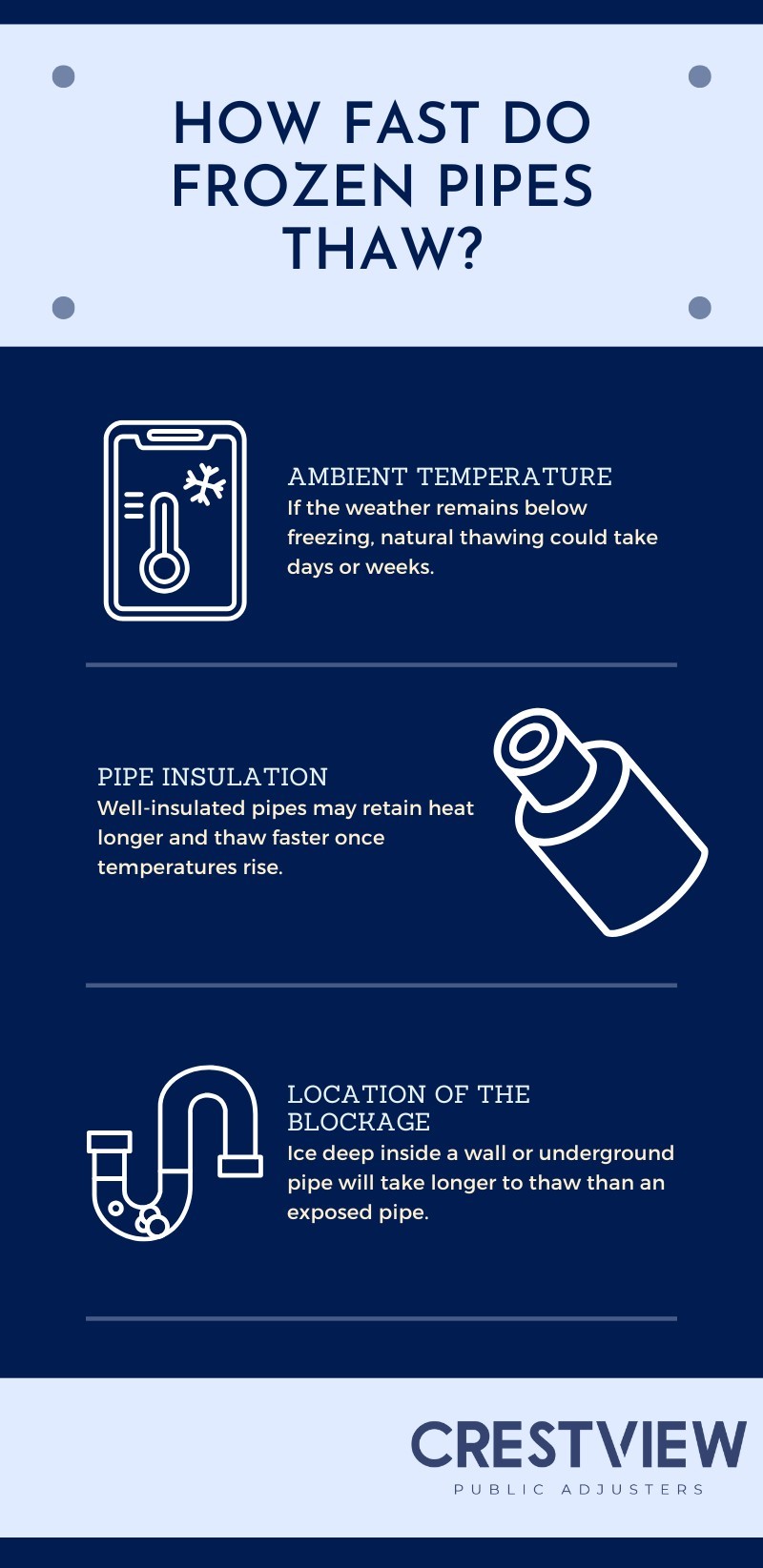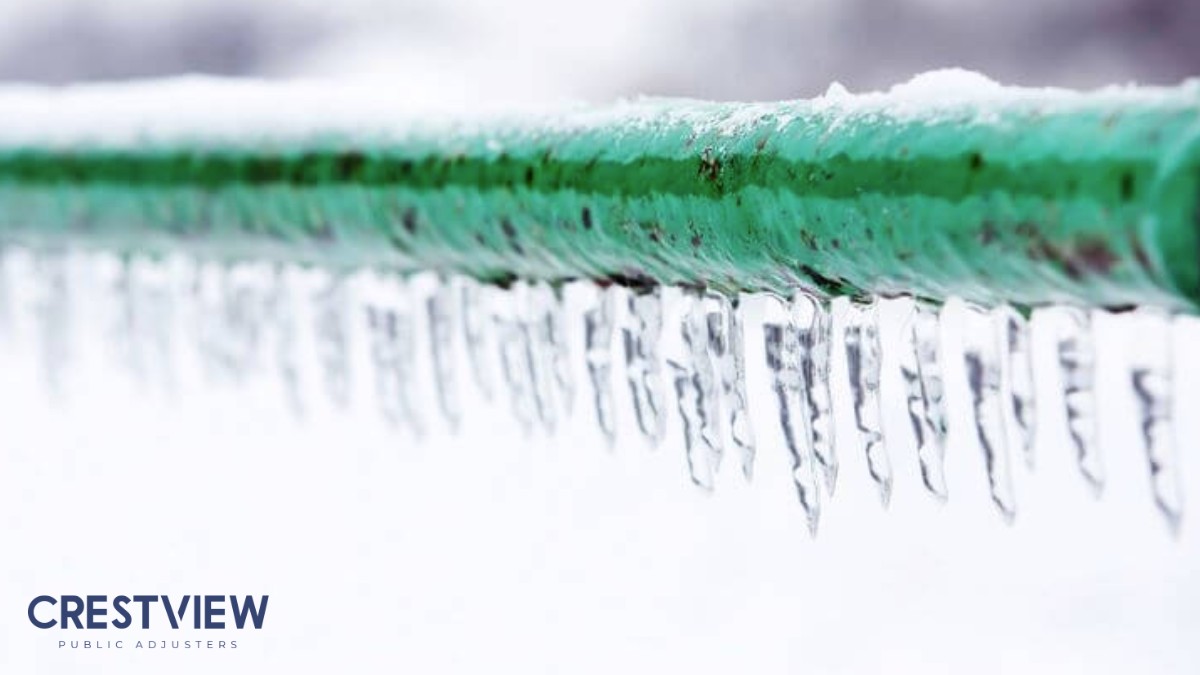Key Points:
- Frozen pipes won’t always thaw on their own, and waiting too long can lead to bursts and costly damage.
- The speed of thawing depends on factors like temperature, insulation, and pipe material.
- Taking proactive steps to thaw pipes safely can prevent extensive water damage and expensive repairs.
Not always. While some frozen pipes may eventually thaw as temperatures rise, waiting for nature to take its course can be risky. Ice inside the pipe expands, increasing the pressure and making it more likely to burst. Even if the pipe doesn’t rupture immediately, it could develop cracks that leak once it thaws. If temperatures remain below freezing, the ice may not melt for days or even weeks, leading to long-term blockages and potential damage.
Instead of hoping for the best, it’s crucial to take immediate action to safely thaw a frozen pipe and prevent further complications.
What Causes Pipes to Freeze?
Pipes freeze when the temperature around them drops below 32°F (0°C), causing the water inside to turn into ice. But not all pipes are equally vulnerable—several factors determine how likely a pipe is to freeze.
1. Poor Insulation
Pipes in unheated areas like basements, attics, crawl spaces, and garages are at the highest risk. If pipes aren’t wrapped in insulation, they lose heat quickly, allowing ice to form faster.
2. Sudden Temperature Drops
Even in milder climates, an unexpected cold snap can cause pipes to freeze. If temperatures fall rapidly overnight, pipes that aren’t normally at risk may become vulnerable.
3. Low Water Flow
Pipes that don’t have constant water movement are more likely to freeze. That’s why homeowners are often advised to leave faucets dripping during extreme cold. Running water helps prevent ice buildup by maintaining movement inside the pipes.
4. Exterior Wall Exposure
Pipes that run along outside walls of a building are more exposed to the cold. If these walls are not properly insulated, the pipes inside them can freeze quickly.
How Long Does It Take for a Frozen Pipe to Thaw?
The thawing time depends on several factors, including:

In most cases, simply waiting is not a reliable solution. Instead, homeowners should take proactive steps to warm up frozen pipes and restore water flow safely.
How to Safely Thaw a Frozen Pipe
If you suspect a pipe is frozen but hasn’t burst, act quickly to prevent damage. Here’s what you should do:
1. Locate the Frozen Section
Start by turning on the nearest faucet. If only a trickle comes out, the pipe leading to it is likely frozen. Feel along the pipe for cold spots or visible frost.
2. Apply Gentle Heat
Use safe, controlled heat sources to thaw the pipe gradually:
- Hairdryer: Direct warm air along the frozen area.
- Heating pad: Wrap the pipe in an electric heating pad set to low.
- Towels soaked in warm water: Drape them over the pipe to transfer heat.
Avoid open flames (such as torches or candles), as they can cause fires or damage pipes.
3. Keep Faucets Open
As the ice melts, water will start flowing. Keep the faucet running to help flush out any remaining ice and relieve pressure inside the pipe.
What to Do If a Frozen Pipe Bursts
A burst pipe can release hundreds of gallons of water in minutes, causing severe property damage. If you discover a burst pipe:
- Shut off the main water supply immediately to stop flooding.
- Drain the system by opening all faucets.
- Call a professional plumber for urgent repairs.
- Document the damage with photos and videos for insurance claims.
Even if a pipe hasn’t burst yet, small cracks can lead to leaks when the ice melts. Monitoring pipes closely after thawing is essential to catch hidden damage early.

Can You Prevent Pipes from Freezing?
Yes! Here are some effective ways to reduce the risk of frozen pipes:
- Insulate exposed pipes with foam sleeves or heat tape.
- Seal cracks and gaps in walls, floors, and foundations to keep cold air out.
- Let faucets drip during extreme cold to maintain water movement.
- Keep indoor temperatures consistent, even when away from home.
- Open cabinet doors to allow warm air to reach pipes under sinks.
Taking preventive steps now can save thousands of dollars in potential damage and repairs.
Get Expert Help with Frozen Pipe Claims
If a frozen pipe bursts and causes water damage, dealing with insurance claims can be overwhelming. That’s where a public adjuster can make a difference.
Crestview specializes in helping homeowners and businesses in Florida, New York, and New Jersey maximize their insurance claims for frozen pipe damage. Our team understands policy details, negotiates with insurers, and ensures you get the compensation you deserve.
Don’t let a frozen pipe disaster leave you with out-of-pocket costs. Contact Crestview today for expert assistance in handling your frozen pipe insurance claim.

